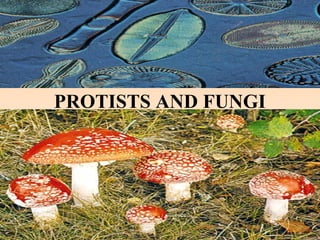
Protist & Fungi
- 2. Commonalities / Differences in the Protist Kingdom • All are eukaryotes (cells with nuclei). • Live in moist surroundings. • Unicellular or multicellular. • Autotrophs, heterotrophs, or both. • Some can move - others cannot.
- 3. 3 categories of Protists • Animal-like •Fungus-like •Plant-like
- 4. Animal-like Protists (Protozoans) *Unicellular *Heterotrophs *4 groups based on movement: those with flagella, cilia, pseudopods and the ‘others’.
- 5. Protozoans with pseudopods • Pseudopods also called ‘false feet’ • Cell membrane pushes in one direction & the cytoplasm flows into the bulge. This allows the protozoan to move, dragging the rest of the cell behind it.
- 6. Pseudopods, cont. EXAMPLE OF HOW PSEUDOPODS MOVE FLOW PUSH DRAG
- 7. Pseudopods, cont. It can form 2 pseudopods to surround & trap food. Then form a food vacuole to break down food in the cytoplasm.
- 8. Pseudopods, cont. • Reproduce by binary fission like bacteria. • Contractile vacuole - it collects extra H2O & expels it from cell • Thin cell membrane - • no definite shape. • Example of a pseudopod - Amoeba.
- 9. Protozoans with cilia • Cilia - hairlike structures - help organisms move, get food and sense environment. • Multicellular with 2 nuclei. • 1 nuclei controls everyday functions • 1 nuclei is for reproduction. • Reproduce by binary • fission or conjugation.
- 10. Cilia, cont. • Oral groove lined with cilia - moves H20 containing food into food vacuole at end of oral groove. • Food vacuole breaks down food and sends through cell. • Anal pore sends out waste. • Example of protozoan w/ cilia: paramecium.
- 11. CONTRACTILE VACUOLE CILIA FOOD VACUOLE ORAL GROOVE FOOD VACUOLE ANAL PORE
- 12. Protozoans with flagella • Organisms called zooflagellates • Use long whiplike part called flagella to move. • These usually live inside other organisms.
- 13. Other Protozoans • Called sporozoans - parasites • Feed on cells & body fluids of hosts Sporozoans like Plasmodium (causes malaria) have more than 1 host: mosquitoes and then humans
- 14. Funguslike Protists • Like animals - they are heterotrophs • Like plants - they have cell walls • Reproduce by spores (tiny cells that can grow into a new organism) • Not in fungi kingdom because they can move at one point in their lives. • An example is mildew.
- 15. Plantlike Protists • Better known as algae • Autotrophs • Size: unicellular to very large • Contain different pigments so they come in different colors. • Euglena: special type of algae -when there is no sunlight they become heterotrophic.
- 16. Fungi Kingdom • Eukarayotes. • Use spores to reproduce. • Heterotrophs that feed in a similar way. • Need warm, moist places to grow. • Examples: yeast, molds and mushrooms.
- 17. Fungi -Obtaining food • use a structure called hyphae to get their food. • Except for yeast which are unicellular. • Hyphae: threadlike tubes. Shape of fungi depends on how hyphae used. AND...
- 18. The fungus grows hyphae into food then hyphae secrete digestive chemicals into food. After food is broken down,hyphae absorb it.
- 19. Reproduction in Fungi • produce thousands of spores with a protective covering: carried by water and air. • spores land in a warm, moist place they grow. AND...
- 20. Reproduction in Fungi, cont. When plenty of moisture, fungi reproduce asexually by releasing the spores. When conditions are not good, they reproduce sexually, making new spores that are different from both parents.
- 21. • Since yeast is unicellular, they reproduce by budding. A well fed cell grows from the body of the mother cell and breaks off from the mother.
- 22. Four classifications of Fungi • Threadlike - produce spores in their threadlike hyphae (ex. Bread mold) • Sac - produce spores in structures that look like sacs (ex. Yeast)
- 23. Club - produce spores in structures that look like clubs (ex. Mushrooms) Imperfect - those that cannot reproduce sexually (ex. Penicillin)